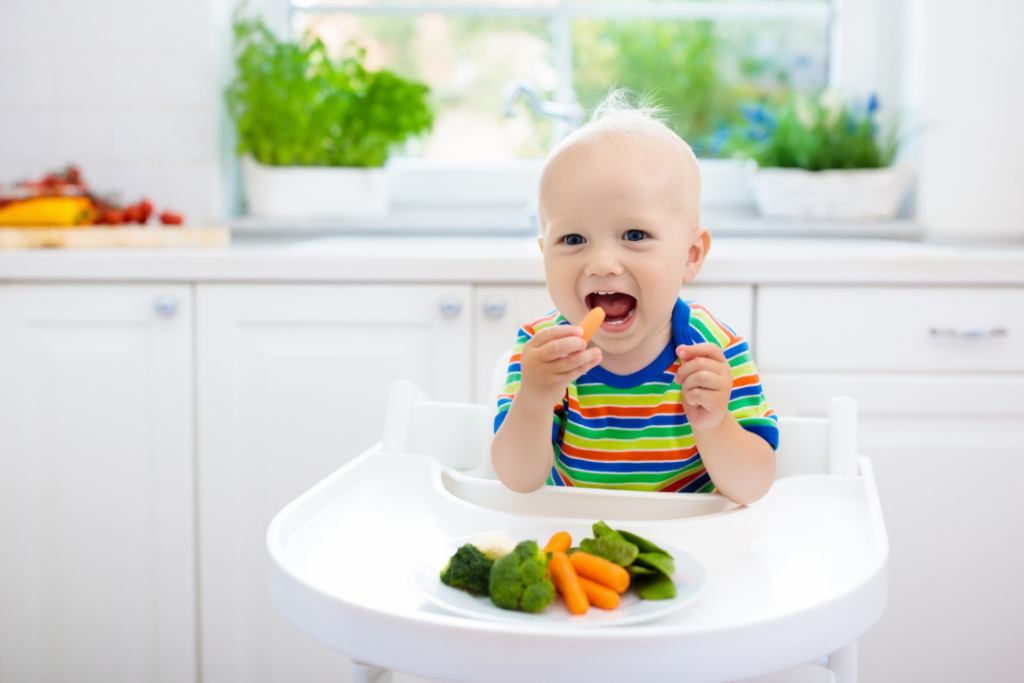When it comes to finger food for toddlers, you want to choose a variety of nutrient and calorie rich foods that meet your little one’s nutritional needs. This article is an excerpt taken from Weaning Sense by Kath Megaw & Meg Faure [Quivertree Publications], read chapter 10 for more details.
Being too busy to eat is very normal for this age and so it is an age where food may need to be delivered in smaller quantities with higher nutrients and calories. Ideas to fortify a meal include:
- Protein
- Calories
- Micronutrients
Once your baby is ready to start self-feeding you can offer whole steamed options with every meal:
Green Peas
Forget the mush and surprise your baby with a new taste and texture by offering whole peas. Green peas can be steamed or boiled.
Steamed or Broiled Fish
Soft, easy to chew, and very nutritious fish is a great first finger food. Coldwater fish, such as salmon, trout, and halibut, provides your baby with DHA, a fatty acid important for brain development in the first 24 months of life. To serve fish to your baby, broil or steam it (without salt if your baby is under 12 months) and cut it in small pieces or separate it into flakes.
Sticky Rice, and Mashed Potatoes
This is a rather unconventional and messy finger food, but babies love self-feeding it. So protect the floor (and your sanity) by placing a plastic mat under your baby’s high chair before allowing him to dip his fingers or even grab the food in his fist. Just remember, playing with food is an important developmental step and the sensory experience is good for learning about their world.
Tender Chopped Meats
Meat is a great source of iron, an important nutrient for babies, especially if you’re breastfeeding (formulas are fortified with iron). Meat is recommended as a first solid food, so it’s a perfect finger food as soon as baby is ready to pick up small pieces, usually between 7 and 9 months. Make sure the meat is cooked until very soft and cut it in small pieces. Ground meat in meatballs and burgers typically has a softer texture and may be easier for your baby to handle.
Soft-Cooked Beans
Once your baby has developed the pincer grasp allowing him to pick up small objects, go beans! Well-cooked beans make an ideal finger food that most babies love for their mild taste and soft texture. Plus, they are nutritional powerhouses, full of protein, fiber, folic acid, and other nutrients. Feel free to open a can, but make sure to purchase BPA-free cans or tetra packs and rinse the beans to get rid of excessive sodium.
Steamed Carrot Sticks and Green Beans
Raw carrots and green beans should be off-limits until your baby has the ability to chew and swallow hard foods safely, typically after 12 months of age. Steamed veggies, however, work well starting at about 7 to 8 months. To make sure the carrots and beans are soft enough, try to squash them between two fingers; if the vegetables turn to mush, they’re cooked perfectly.
Frozen Yogurt Drops
These are as much fun to prepare as they are to eat. To make these yummy and probiotic-rich treats for your baby or toddler, fill a zip-top bag with flavored or plain yogurt, snip off one of the corners and squeeze drops of yogurt on an oiled baking sheet or plate. Freeze the drops until solid and then store them in an airtight plastic bag or container in the freezer. Serve frozen for an easy snack or fun dessert.
Noodles or Pasta
Having pasta for dinner tonight? Invite your baby to join you at the table. Pasta and noodles are many babies’ favorite foods because they’re delicious and are easy to handle. To prevent choking, make sure the pasta is well cooked and cut into small pieces.
Soft, Raw Fruit
Such as Watermelon and Peaches. Naturally soft fruits and vegetables do not have to be cooked for your baby to safely eat them. Wholesome choices like watermelon, peaches, tomatoes, and avocado can be cut into elongated pieces or small cubes to make it easy for babies as young as 6 months to grab. In any shape, they’re nutritious and ultra-easy.
Broccoli Florets
Before babies master the pincer grasp, they use their palm to grab, making broccoli florets on a stalk just right as a first finger food shape. Cook the broccoli well before you offer it to your baby. The somewhat bitter taste of vegetables like broccoli may be challenging for sensitive palates, but don’t give up. The good news is that with consistent exposure babies are likely to accept even less-liked foods over time.
Cucumber Strips
Cucumber strips may be hard for your baby to bite before he grows teeth, but they work wonders for soothing sore gums in the meantime. To prevent choking, cut cucumbers into long and wide strips so that your baby can gnaw on them without biting off too big a piece.




